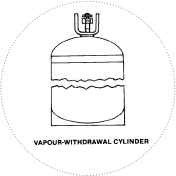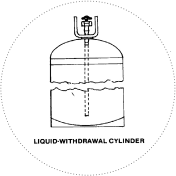Propane is liquefied by compressing and/or cooling propane gas and placing it in metal cylinders or tanks designed for that purpose. The compression rate of one litre of liquid propane produces approximately 270 litres of propane gas. This explains why so much energy (BTU’s) can be contained in a small cylinder and why safety procedures must be followed so that this energy source does not become a hazard to workers.
Propane is packaged in a number of storage containers and sizes to meet a variety of applications.
Cylinders
- Propane cylinders are a portable means of storing and transporting propane
- Cylinders are regulated by Transport Canada.
- Cylinders bear a Transport Canada stamp on the collar.
- Marks are stamped onto the collar of cylinders identifying the original date of manufacture and any subsequent re-qualification dates.
- Portable cylinders must be inspected and requalified every 10 years and it is against the law to fill an outdated cylinder. The requalification of a cylinder must be done by organizations that have the appropriate equipment, training and certification to do so, and have been certified by Transport Canada to do the work.
- Never throw your propane cylinder in the garbage. To dispose of your old cylinder, drop it off at facility that accepts propane cylinders for disposal.
Tanks
- Propane tanks are typically more permanent and larger storage installations than cylinders.
- Tanks are regulated by provincial and territorial authorities.
- Inspection and requalification requirements for tanks differ by jurisdiction, tank size and design.
- Tanks have a stamped plate that shows a Canadian Registration Number (CRN).
The size of cylinders/tanks that are commonly used for roofing applications are 9.1 kg (20 lb), 13.6 kg (30 lb), 18.1 kg (40 lb), and 45.4 kg (100 lb).
The pressure within the container varies depending on the outside temperature. The pressure increases as the temperature rises causing an expansion of the liquid. For this reason, containers are never fully charged with liquid, but have a vapour space at the top of the tank to allow for normal expansion. It is illegal to fill propane cylinders or tanks to more than 80% capacity, allowing room for the volume changes due to temperature variations.
All propane cylinders are equipped with the following:
- Relief Valve
The safety relief valve is one of the most important and vital valves on any propane container. All propane tanks and cylinders are required to be fitted with pressure relief valves that are designed to relieve excess pressure. This release is generally over in seconds, the valve reseals and remains closed until the pressure builds up again. Cylinder relief valves are set at 2585 kPa (375 psi). The function of a safety relief valve is to keep a propane tank from rupturing in the unlikely event of excessive internal pressure buildup. Propane tank relief valves are also known as pop off valves, or pressure venting valves. - Service Valve
The propane service valve is the controlling mechanism that allows propane to flow into the hose. The service valve, on the propane tank, is the valve that controls 100% of the gas flow into the gas system. Basically, propane service valves function as the “on/off switch” in propane gas systems and is for vapour service only. Proper operation of the service valve is important for safety reasons and gas utilization. If you smell propane, the service valve should be turned off immediately!The operation of a propane tank service valve is similar to that of a water faucet. The valve consists of a handwheel that closes and opens gas flow by turning the wheel clockwise and counter-clockwise. Inside the valve is a stem and seat that when opened, allows gas to exit the tank/cylinder and when closed, stops the flow of gas. Although it may seem that the functionality of a service valve is identical to that of a water faucet, but it has one very distinct difference because the proper use of propane requires a regulator which reduces the amount of pressure introduced into the hose at a level that is safe and acceptable for the application requirements. In other words, the service valve is only used for turning the gas on or turning the gas off, not for regulating the flow of gas.
- Bleeder Valve (Fixed Liquid Level Gauge)
The bleeder valve is designed so that during the filling process, when the propane going into the tank reaches 80%, liquid will come out of the opened valve. The fixed liquid level gauge tells the person delivering the propane that the tank is at the maximum safe capacity.When installed by the tank manufacturer, the dip tube is pre-set to indicate when the tank is legally full during the filling process.
- Protective Collar (Neck Ring)
The valve of a propane cylinder is required to be protected by a protective cap or collar, also called a neck ring. The absence of a protective collar leaves the cylinder’s valve(s) susceptible to serious damage. An unprotected valve hit hard enough to break off can allow liquid propane to escape at a dangerously fast rate. The escaping propane can act as propulsion for the cylinder allowing it to become a dangerous projectile. - Foot Ring
The bottom of all propane cylinders is required to have a foot ring. The foot ring serves a very vital role in the protection and continued usability of a propane cylinder. The foot ring ensures the cylinder stands in an upright and level position while also keeping the storage container from contacting the ground. The absence of a foot ring would allow the bottle to easily fall on its side.
Propane Cylinder Types
Propane cylinders are manufactured to suit the type of burner used on the appliance and are identified by the type of valve installed on the cylinder. Hand-held torches usually operate with vapour-withdrawal cylinders. Kettles and tankers use liquid withdrawal cylinders or tanks.
Vapour Withdrawal System
 Most hand-held torching equipment is designed to work with vapour-withdrawal propane cylinders. Vapour withdrawal cylinders are identified by the cylinder valve, which incorporates a female fitting with internal threads. The matching connector has a male fitting with external threads, which installs into it with a counter clockwise rotation.
Most hand-held torching equipment is designed to work with vapour-withdrawal propane cylinders. Vapour withdrawal cylinders are identified by the cylinder valve, which incorporates a female fitting with internal threads. The matching connector has a male fitting with external threads, which installs into it with a counter clockwise rotation.
Containers for vapour-withdrawal service are usually 45.4 kg (100 lb) capacity or smaller portable cylinders. Unlike the liquid service cylinders, they have no dip tube. Only vaporous gas can be withdrawn.
The main service valve on vapour-withdrawal cylinders has a female outlet connection with a left-hand (POL – put on left) thread and a safety relief valve set at 2585 kPa (375 psi). Vapour- withdrawal cylinders may not be equipped with an excess flow valve.
Except for vapour-withdrawal cylinders designed for horizontal use, all propane cylinders should be transported and used only in a vertical position.
Liquid Withdrawal System
Most roofing kettles and tankers are designed to work on a liquid withdrawal system.
 The cylinder valve that incorporates a male fitting with external threads identifies liquid withdrawal storage cylinders. The matching connector has a female fitting with internal threads, which install with counter clockwise rotation. (POL – put on left).
The cylinder valve that incorporates a male fitting with external threads identifies liquid withdrawal storage cylinders. The matching connector has a female fitting with internal threads, which install with counter clockwise rotation. (POL – put on left).
Liquid propane is drawn from the bottom of the storage cylinder (by pressure within the cylinder) through a dip tube that attaches to the cylinder valve assembly. Liquid propane is transferred to the burner application where it is first vaporized then ignited.
Containers for liquid-withdrawal service are usually 45.4 kg (100 lb) capacity, portable cylinders equipped with a dip tube and main service valve. The valve has a left-hand (POL) thread male outlet connection so that it cannot be inter-changed with cylinders for vapour-withdrawal service.
The liquid withdrawal valve functions only with additional specialized fittings supplied by a propane company for liquid evacuation. Without these required fittings, the liquid withdrawal valve is unusable. The liquid withdrawal valve is attached to the tank and itself is in the vapour space. The dip tube that reaches the bottom of the tank is in direct communication with the liquid space of the propane tank which allows it to be used for liquid propane service or liquid withdrawal. The valve itself consists of a powerful spring holding a seat disc in a firmly closed position. The seat disc (left) is opened by attaching a second valve to the exterior of the liquid withdrawal valve outside the tank. This secondary valve is available only through a licensed propane company. Once the liquid withdrawal valve has been successfully opened by attaching the second valve to the exterior portion of the liquid withdrawal connection, propane liquid can be withdrawn. The liquid withdrawal valve has a safety mechanism built in called an excess flow valve. If the flow of liquid reaches a rate in excess of its design, the valve will close, hence the name “excess flow valve”.
Each cylinder is equipped with a safety relief valve set at 2585 kPa (375 psi), an excess flow valve to stop the flow of propane in case the outlet nipple breaks, and a tag or other means of indicating that the cylinder is for liquid-withdrawal service only.
